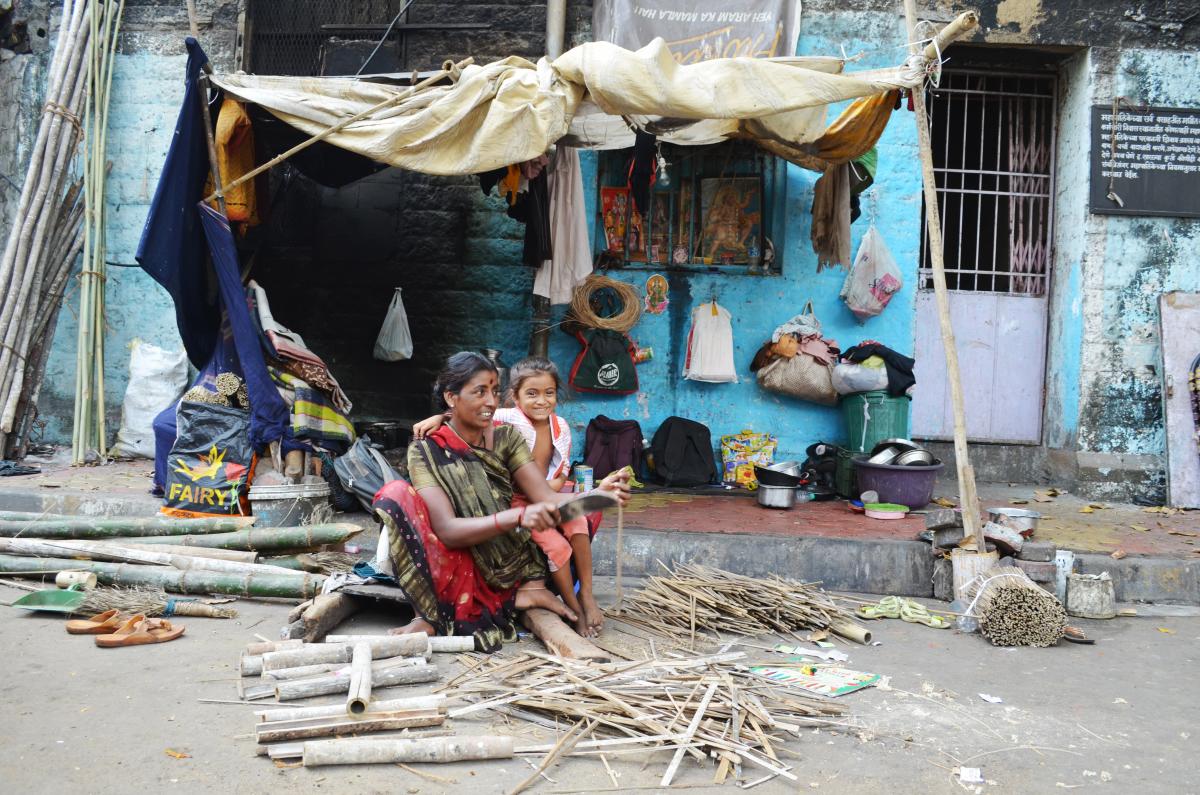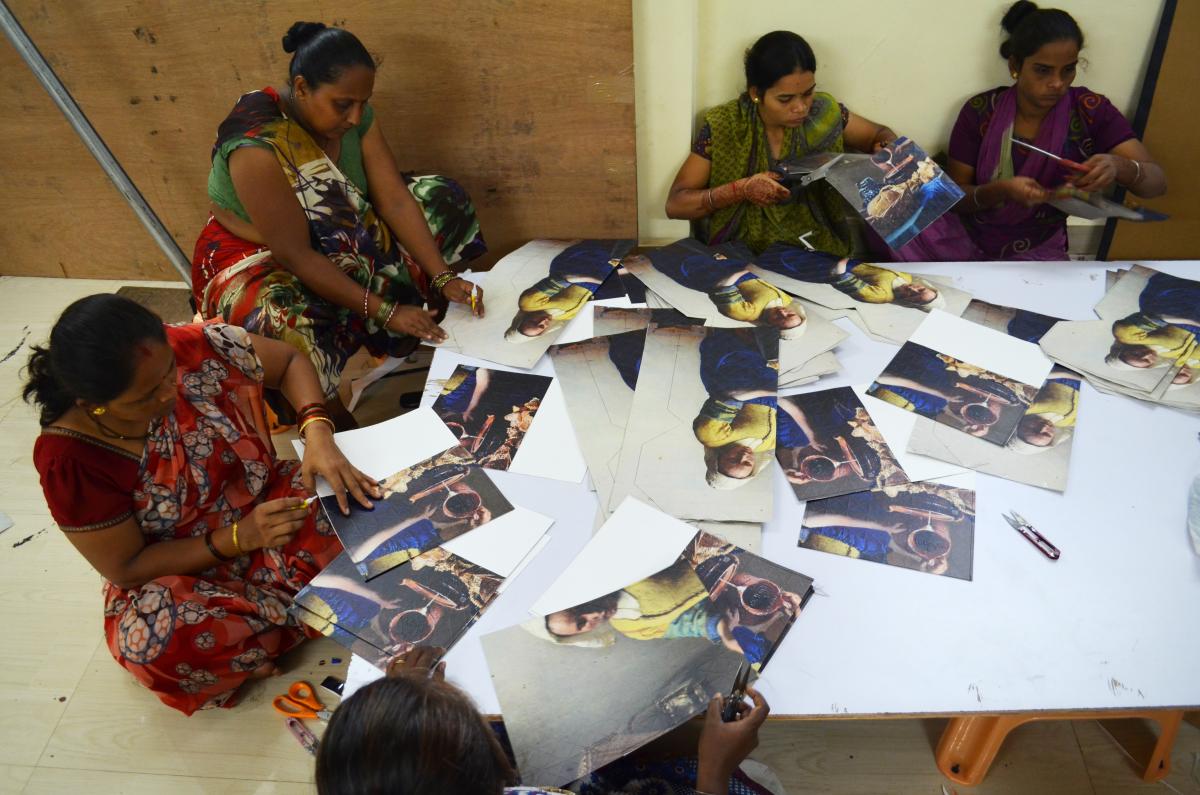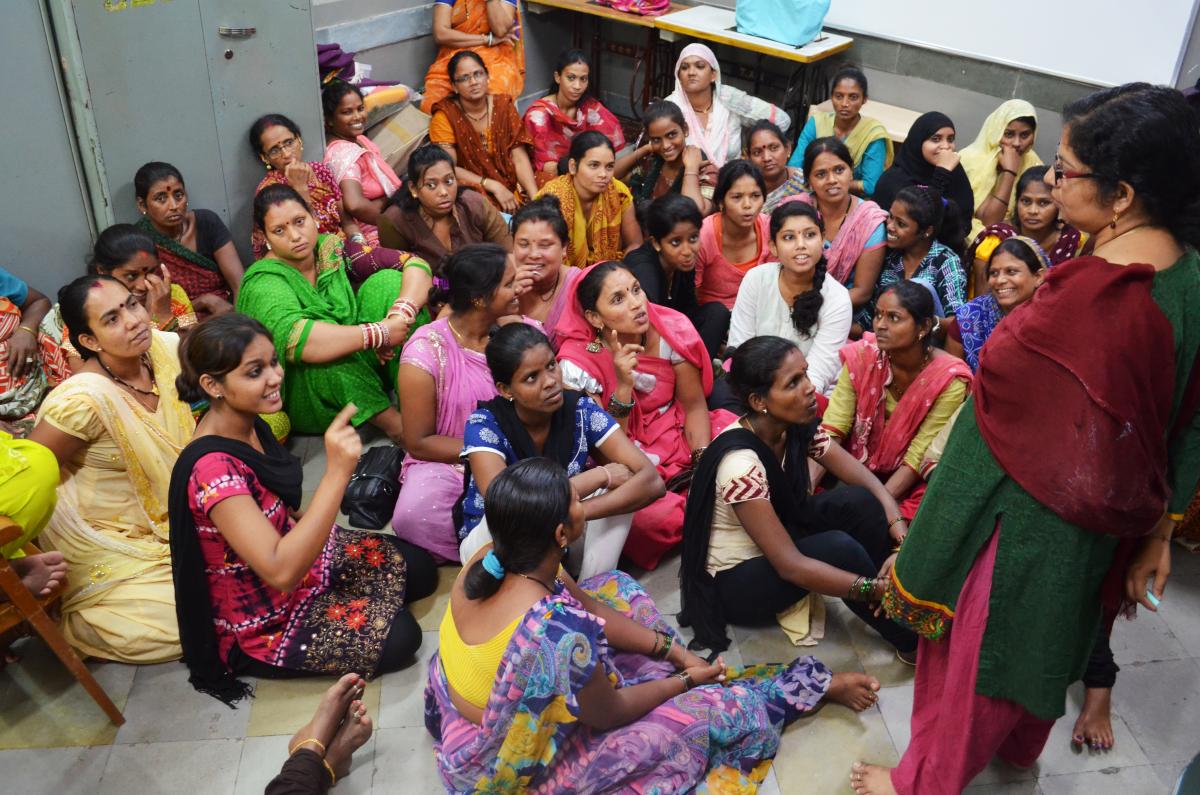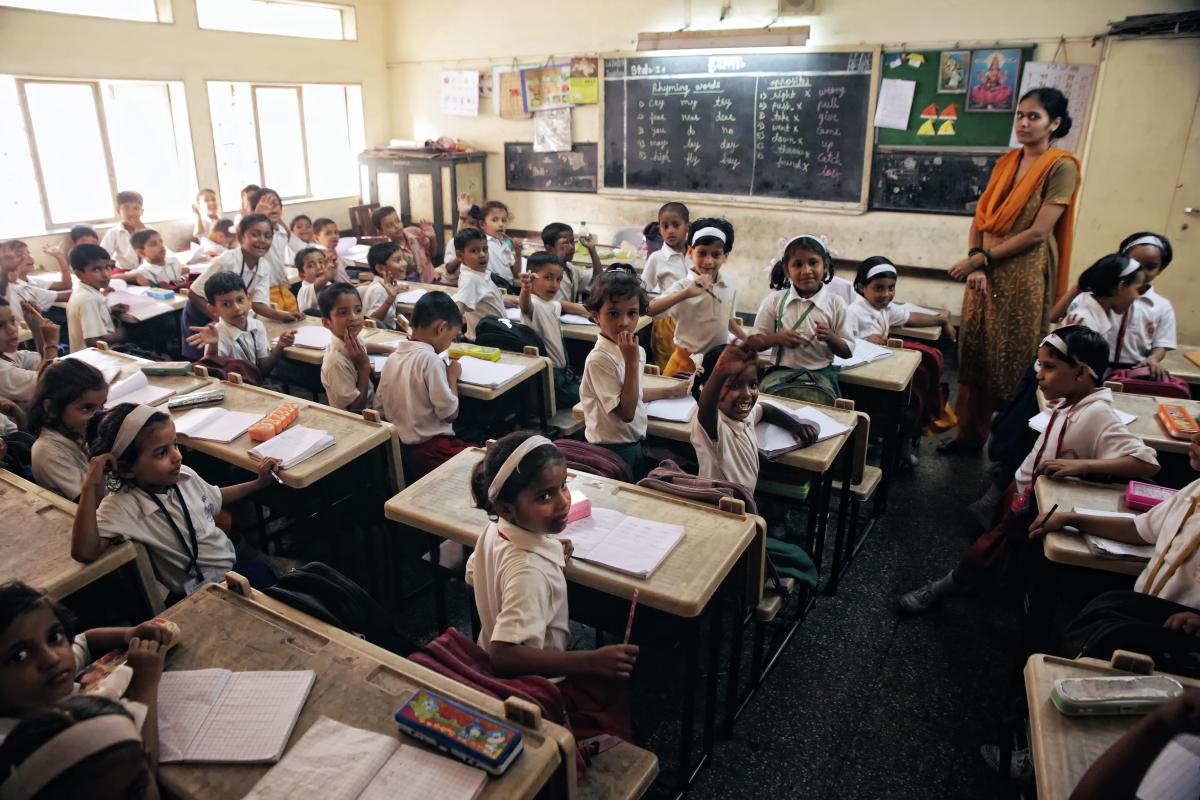A Vase That Makes a Difference
To escape the poverty of one of the world’s largest slums, children need a miracle. Laurien Meuter and Pepe Heykoop offer them one.
Cover Photo: Design store in The Hague selling the paper vase. (Photo: Peter Bilak)
A casual shopper spots a beautiful vase in a designer shop window in The Hague. Myriad triangular folds cover its complex surface in an intriguing design. She walks into the shop for a closer look. To her surprise, the object is not a vase, but a paper vase cover, an aesthetic object rather than a functional one. A further surprise is that it’s a flat-pack object sold in an envelope, going from two dimensions to three with just a few clever folds. The third surprise is that it costs only €19 (US$22.40). Without hesitation she buys it on its visual merit.
Her purchase is helping to make a dream come true not only for Dutch duo Laurien Meuter, founder of Tiny Miracles Foundation, and Pepe Heykoop, designer of the vase cover, but also for the families of Foras Road, Mumbai’s red light district, where the covers are produced.
The vase cover’s story began when Meuter moved from Amsterdam to Mumbai to work in the banking sector. Her bank employed a coffee server, a cheerful man named Mohan, who would greet her every day with a big smile. She began to wonder how he lived, and so she invited herself to his house for dinner. Honoured by her request, Mohan spent a week preparing to receive the Westerner at his home, a small rectangular space with two bags of belongings on a pavement deep in the slums of Mumbai.

The Pardeshis, a street community in Mumbai’s notorious Dharavi, one of the world’s largest slums, are traditionally basket weavers. The woman in the photo joined the Tiny Miracles project to obtain a job, education and healthcare for her and her four daughters. (Photo: Pepe Heykoop)
Mohan and his daughter were what they call pavement dwellers in Dharavi, where over a million people are crowded into about 200 hectares (500 acres). With around one toilet per 1,440 residents, the slums are ravaged by disease. Rent starts at about ₹2,500 (€33.10/US$39.00) a month, depending on the level of shelter, but wages, for those who have work, average about ₹5,000 (€66.20/US$78.00) per month, and although Mohan earned slightly more, it was not enough to pay for a place to live, let alone tuition for his daughter, a cost of ₹15,000 (€200/US$234) per year.
Without hesitation, Meuter offered to pay for his daughter’s education, a small gesture that would be the beginning of a crusade to improve the quality of life for hundreds of people. After consulting with Asha Rane, an 80-year-old professor of social sciences familiar with four slum areas across Mumbai, Meuter chose to begin with the children of the Pardeshis, a community in the heart of the red light district where everyone shares the same last name. The Pardeshis, like most people in the slums, were illiterate and worked in professions determined by their caste. Although Dalit, the caste commonly known to the Western world as ‘untouchables’, heir to the foulest jobs available, the Pardeshis are basket weavers, so they managed to avoid cleaning up toxins and toilets. Still, ‘most of the men in this community get drunk and rely on their children, prime targets for prostitution, to work, and on their wives to cook and clean,’ says Meuter.
Meuter’s first intention was to send about 20 Pardeshi children to English school, as she felt that learning Hindi would be less effective in getting them out of the slums. She enlisted the help of Grace Joseph, who would later become community manager of the project, to find a school. The first 15 schools approached, however, rejected the idea, unconvinced that the parents or the foundation would continue to pay tuition. The parents were also suspicious at first, thinking that Meuter was trying to convert them to Christianity. Why else would a tall, white-skinned, blond-haired, Dutch woman want to help them?
You seem to enjoy a good story
Sign up to our infrequent mailing to get more stories directly to your mailbox.One school eventually agreed to accept the children, and the parents eventually agreed to send them, but during the project’s first year it became evident that the way out of poverty was not as straightforward as might be hoped. The parents, themselves uneducated and with little understanding of the value of education, would often keep their children out of school to work, and those children that did go to school were often hungry and malnourished, unable to focus on learning.
Meuter came to the most crucial realisation in her quest: focusing only on the children was futile, and she would have to widen her scope to include whole families, and her charitable efforts would have to evolve into a multifaceted project. ‘If there was really to be a difference here, the parents would need work, at least the women, and they as well as their children would need to be educated about self-sufficiency, self-worth and self-confidence.’

The Pardeshi women making vases depicting Vermeer’s Milkmaid for the Dutch National Rijksmuseum. Tiny Miracles operates two workshops in Mumbai, producing a total of up to 20.000 items per month. (Photo: Pepe Heykoop)
Meuter turned to Heykoop, her cousin, a recent graduate of Design Academy Eindhoven: ‘Pepe, I need to create work for the parents—that’s the only way the children can go to school. Can you design something that they can make?’ Heykoop was eager to get involved, and together they began to think about a product that would provide a sustainable business model. They felt that the only way to generate enough revenue to support the project was to target first-world designer boutiques, and the Pardeshi baskets were not a viable option. Practically speaking, they needed a product that was less expensive to produce in large quantities and easier to ship. Furthermore, they wanted something that would sell primarily because of its quality as a design object, not just because of its fair-trade or charitable aspect, although that angle would inevitably play its role in the marketing.
The idea of the paper vase cover was the result of two years of sketching, exploring and experimenting with numerous materials. Production requires only two skills, folding and stitching, and the final result folds flat for shipping. Working with paper makes it easy to produce a variety of designs to suit nearly any décor, transforming any empty bottle into an object as beautiful as it is useful.
People would first notice the paper vase cover as a designer product and not because of the story behind its making. Selling around 100 covers a day worldwide, there’s no doubt that the product is successful in its own right. Meuter says, ‘We’ve created a design that doesn’t have that poverty poor feel to it—people buy it because they like it and not out of sympathy and that’s the key to its success.’ — Laurien Meuter
His design finished, Heykoop started to teach the women how to fold and sew. Sitting on the floor with 40 women gathered around him (the Pardeshis don’t like sitting on chairs), he gave each of them a piece of paper and asked them to fold it exactly in half. Not one returned with a straight fold. There was a moment of disbelief, quickly followed by a brave smile. He hadn’t come this far just to give up over a few crooked folds. He decided to make it into a game to encourage them to learn: ‘For every fold you get right, you can fold it in half again; for every fold you get wrong, I’m going to sit on the paper, and you are out of the game.’ With just a couple of Hindi phrases, dhiyan se, ‘be careful’, for the folding and seedhe, ‘straight’, for the cutting and sewing, he began to teach the women invaluable life skills. In the end, they were all able to make the paper vase cover, and it seemed like they were safely on their way to success.
Over time, however, Heykoop noticed that the quality of workmanship was beginning to decline. The project was turning into a mass-production operation where the women favoured quantity over quality. Although a final checker had been appointed, she would often let imperfect objects pass due to the pressure and responsibility she felt towards the women. Undeterred, Heykoop thought of a way to harness that sense of responsibility to promote quality control. He divided the women into Group A and Group B. Group A would send their finished pieces to Group B to check and if Group B approved the quality, then the pieces were sent to the final checker. If any were returned, Group B would have to fix them, but Group A would get paid. Of course, the same process applied to Group B’s work as well. This system was a success, and production actually increased as the women became faster and more precise at their work.

Community manager Grace Joseph (standing) conducting a social awareness session, part of a two-day-a-week programme that encompasses a wide range of services, including health checkups, cooking classes, a visit to a local bank and an explanation of how government works. (Photo: Pepe Heykoop)
As the project gained momentum, the women began to earn wages unheard of in their community. One of the advantages of working with paper is that the cost of the raw materials is relatively low, and the vase covers can be sold at a profit that enables the foundation to pay the women fairly according to UN standards while also supporting its continued growth. Meuter breaks down the numbers: ‘We sell the vase cover to shops at €8 (US$9.40) and they sell at €19 (US$22.40) including VAT. The women get €1 (US$1.20) for every cover they make. The remaining €7 (US$8.20) goes towards materials, shipping etc. One euro is actually too high, since the women can make one cover in about 20 minutes. They used to earn one euro a day, but we increased their salary.’
Unexpectedly, that salary increase was also a source of problems during Tiny Miracles’ trial-and-error learning process. For one thing, women suddenly started working faster to earn more, compromising product quality again. For another, the demand for jobs jumped beyond the foundation’s capacity to provide work. Another problem concerns future expansion: ‘When introducing a new product, the women will need to learn how to make it, which takes time before they get fast, and they’re not going to be that willing to take a drop in their income.’

Finding a school to work with was a challenge, and the first 15 schools approached rejected the idea of taking on slum children whose parents are illiterate and lack funds to pay tuition. The foundation not only covers the fees, but also makes sure that the children are neat and clean when they go to school, emphasising education as one of the foundation’s pillars for bringing about lasting change. (Photo: Bart Coenders)
Dealing with money and managing personal finances were entirely new skills for the women. One of the initial steps Meuter took was to help each woman open a bank account into which their wages would be paid. ‘On the very first occasion they were paid, a mass of women stood outside the bank in disorder, throwing rocks at it, asking the building to give them their money. Even the concept of a bank was foreign to their thinking,’ says Meuter. The following day, she organised a tour of the bank with the general manager, as well as a class in how to use the bank and what it meant.
Today Tiny Miracles is structured around five ‘pillars’, of which ‘employment’ is only one, and not even the first on the list. That position belongs to ‘social awareness’, which includes learning how to use a bank, but also topics like hygiene, domestic abuse and family planning. ‘Healthcare’ includes regular doctor and dentist visits as well as addiction rehabilitation, healthy cooking and exercise. ‘Employment’ is the third pillar, followed by ‘education’, the dream that started the whole project, and which now provides after-school homework classes, English lessons and computer instruction. Finally, the foundation promotes ‘celebration’, the recognition that material well-being is useless unless it is enjoyed, and that cultural traditions are an important part of a healthy identity. Tiny Miracles pays 100% of the education and healthcare costs in the first years of the programme, but its contribution decreases with time, expecting the women to gradually assume more financial responsibility until eventually they are covering their own costs. ‘The idea is that over the ten-year project, the women would learn how to manage their finances and the importance of visits to the doctor themselves,’ Meuter says.
Six years in, it is certain that this project has already had a significant impact on the community. Tiny Miracles currently employs 150 people who earn about €25 (US$30) per day, but the total number of people reached by the programme is 1,300, with plans to expand faster in the coming year. With 250,000 vase covers sold worldwide, the foundation is opening a way out of the slums, but whether the Pardeshis will grasp that opportunity is yet to be seen. ‘That the Pardeshi community was given a choice, an opportunity to get out, that’s the biggest change for them. Before this they were chasing a miracle,’ says Meuter.
To be sure, the project raises many issues. Would it be better and more culturally sensitive to sell the baskets that are part of the Pardeshi history and tradition? Will the project have lasting impact? Can it be replicated in other communities in other conditions? And purely practically, how long will the vase cover be marketable, and will the next product be another hit?
There are still many questions to ask, but only time will reveal Tiny Miracles’ overall success or failure. Although the project has been running for six years, the slum where it operates has existed for more than 130, and neither cultures nor economies change overnight. In the meantime, every vase cover sold helps to hold a door open for the Pardeshis. Now it is up to them to decide where it leads.

